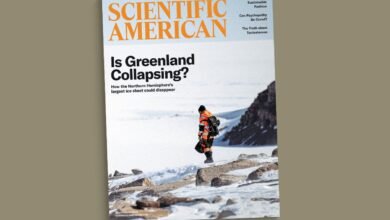COP30 In Brazil Highlights Global Climate Challenges and Indigenous voices

Kendra Pierre-Louis: For Scientific American’s Science Quickly, I’m Kendra Pierre-Louis, in for Rachel Feltman. You’re listening to our weekly science news roundup.
Let’s kick things off with some climate news. Last week the 30th United Nations Climate Change Conference, better known as COP, wrapped up in Brazil. I talked to Zoya Teirstein, a senior staff writer at Grist who was on the scene, to catch up on all things COP30.
Welcome, Zoya.
On supporting science journalism
If you’re enjoying this article, consider supporting our award-winning journalism by subscribing. By purchasing a subscription you are helping to ensure the future of impactful stories about the discoveries and ideas shaping our world today.
Zoya Teirstein: Oh, what a pleasure to be here.
Pierre-Louis: Going into COP can you tell me what people were sort of hoping to expect out of this conference?
Teirstein: Yes, so [Luiz Inácio Lula da Silva], the president of Brazil, and [André Corrêa] do Lago, the president of COP, set high expectations for this conference. They want it to be sort of negotiation starts turning into implementation. And that’s been a goal for these international climate summits.
I think the word “conference” doesn’t really get at the stakes of this summit; it’s really—most of the world’s nations are here talking about how to solve the greatest threat that humanity faces, climate change, and what happens here really sets the tone for whether or not the emissions causing the climate crisis get reduced or not.
Pierre-Louis: And you said most of the world is there. Who’s not there?
Teirstein: Well, notably, the U.S. is not here this year. That is because President Donald Trump has, for a second time, withdrawn the U.S. from the Paris climate agreement. The Paris climate agreement is an international treaty that aims to keep global warming at 1.5 degrees Celsius compared to preindustrial levels and “well below” 2 degrees C of warming.
The news there is that we are on track to surpass that target and potentially even surpass 2 degrees C of warming. And that is bad news because, you know, right now, with the planet at 1.2, 1.3 degrees, roughly of warming, we’re already seeing catastrophic climate impacts, and that’s really been a topic discussion here at COP as well, is: How do you prepare nations for those impacts now that it’s super clear that they are, in fact, happening and at a rapid pace?
Pierre-Louis: It’s been, what, [almost] 10 years exactly since the Paris climate agreement?
Teirstein: Yep, that’s right.
Pierre-Louis: A critic might say, “Nothing’s been accomplished in these past 10 years. Every year people gather together at a COP, and nothing gets done.” What would you say to that person?
Teirstein: Well, that’s not true. Without the Paris climate agreement we would be on track for even more catastrophic warming. There have been significant steps taken by many nations around the world to reduce their emissions, to preserve forests, to take a variety of different steps. All is not lost.
But I think that, you know, someone looking at this conference and wondering, “Has there been enough progress to really achieve what the Paris Agreement set out to do?” the answer is hell no. There has been not enough progress at all on this subject. And that’s not really the fault of technological advancements or our capacity to actually adapt climate change and mitigate climate change; it has to do with the fact that the political will to do those things is simply not there.
Pierre-Louis: One of the things that’s come up quite frequently is that the poorer countries, especially low-lying island states, are some of the most at risk in terms of climate but also some of the least contributors to it. Has that come up again this year?
Teirstein: Certainly. That is a huge topic of conversation here. With small island states that [need] funds to both mitigate climate change—so these low-lying island states are being inundated by sea-level rise, by cyclones and typhoons, and so the question is, “Will that money come through?” And the answer is, you know, it’s not really coming through.
And there’s many reasons why that is, and part of it is that many other states are sort of cash-strapped right now. They’re trying to bolster their military operations in light of Russia’s war with Ukraine. For example, inflation is still high after the COVID-19 pandemic, and the U.S., one of the wealthiest countries in the world, is no longer engaging in international climate diplomacy. It’s a tricky place to be in right now.
Pierre-Louis: And what are we seeing coming out of the conference?
Teirstein: Germany just put €1 billion, [about] $1.1 billion, to [Brazil’s] tropical forest fund.
The Indigenous presence at COP 30 has been very strong. The aim of having this COP sort of at the mouth of the Amazon was to better include marginalized groups, such as Indigenous groups that, that live in the Amazon, in COP negotiations, and they showed up in a pretty forceful way.
They sort of pushed their way into the conference grounds, past the barriers, and really made their voices heard, and that led to new discussions with the Brazilian government around how to better protect Indigenous regions and territories from deforestation and industry and that kind of thing. So in that sense there’s been sort of progress in terms of really hearing from groups that are normally sidelined in these conversations.
Pierre-Louis: That seems like a positive note to end this conversation on. Thank you so much for taking the time to speak with us, Zoya.
Teirstein: Great to be here. Thanks, Kendra.
Pierre-Louis: Now for some health news. A massive study published last week in Science Advances found no link between consuming fluoride at recommended levels and cognitive decline.
Although water fluoridation has long been a contentious issue, in recent months it has gained new scrutiny. U.S. Health and Human Services Secretary Robert F. Kennedy Jr. has been an outspoken critic of adding fluoride to public drinking water. He claims that exposure to the mineral has been linked to, quote, unquote, “IQ loss,” especially in children.
To investigate if there’s such a link researchers analyzed data from a group of Americans who were involved in long-term studies by the National Center for Education Statistics between 1980 and 2021.
This new study took the data of more than 58,000 individuals who were part of the initial NCES sample in 1980 and estimated the amount of fluoride exposure the participants had experienced. They [scientists] then compared that data with [the participants’ results on] standardized tests from high school. The research found that young people exposed to the recommended levels of fluoride performed slightly better on all academic measures than those who were not.
Of that initial group the NCES study also followed a smaller subset of roughly 27,000 from 1982 through 2021, with roughly half of this subset still participating in the study in 2021. In adulthood researchers detected no measurable differences in memory, attention or other cognitive skills between those with the suggested amount of fluoride exposure and their peers.
Though the study did not look into why kids exposed to fluoride might have performed better on tests, study co-author John Robert Warren hypothesized that those students might have been less likely to miss school because of illness.
And finally, if you’ve ever looked at a raccoon and wondered, “If not pet, why pet-shaped?” you may be in luck. Researchers have found evidence suggesting that urban raccoons might be becoming more tame. A recent study suggests that raccoons in cities are undergoing physical changes in response to living around humans.
Scientists have long noticed a connection between tameness and traits such as a shorter face, a smaller head, floppy ears and white patches on an animal’s fur. But it wasn’t until 2014 that a team of evolutionary biologists realized many of these traits are tied to a group of cells known as neural crest cells. These cells form during embryonic development and play a role in the development of different kinds of cells in the body. The scientists’ theory is these cells lead animals to have a dampened fear response and are also linked to physical changes such as a shorter muzzle.
This new research examined the snout lengths of city-dwelling raccoons and their rural counterparts to determine whether [the scientists] could actually see signs of the animals taking on traits associated with tameness. It turned out that the urban raccoons had snouts that were 3.5 percent shorter than their more pastoral peers.
There’s still more to learn about the process of domestication. In the meantime, no matter how cute your local trash panda is, do not bring it home.
That’s all for today’s episode. Tune in on Wednesday, when we get wild—with turkeys.
Science Quickly is produced by me, Kendra Pierre-Louis, along with Fonda Mwangi and Jeff DelViscio. This episode was edited by Alex Sugiura. Shayna Posses and Aaron Shattuck fact-check our show. Our theme music was composed by Dominic Smith. Subscribe to Scientific American for more up-to-date and in-depth science news.
For Scientific American, this is Kendra Pierre-Louis. Have a great week.




